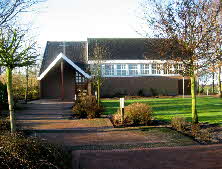|
Even at the dawn of civilization there was a desire for contact with people on the other side of the moor. A thousand years ago the native people found a way to cross the moor without having to go the long way around the edges of the high moor. Between the two ancient villages on the geest, Strackholt and Aurich-Oldendorf, there was a log road (a corduroy road) crossing the moor. These roads (paths) built with logs and branches were called "Speken" or "Spetzen" in the vernacular. This Spetze between Strackholt and Aurich-Oldendorf is mentioned as early as 1454 in a document from the chieftain, Hippeko of Strackholt. The troops of Duke Heinrich of Brunswick stormed through Ostfriesland in 1514. Beninga described the situation: “They advanced on the Spetze, raiding and burning all day long”.
The peasants in the surrounding villages put the moor to good use by using it for their fuel. The livestock were grazed in areas that had been drained and where grass and heather had sprung up. They considered the moor their property where "the sod had been harvested and the livestock had pastured."
A bridge was built near Ulbargen in 1747. Two years later, at the lower end of the structure, another sluice was needed. In 1751, after various difficulties which had hindered the development of the moorland, the state withdrew from the development of the area. The Spetzerfehn Company, a privately owned organization arose under Haneborger (who had previously advised against the development of the moor) and Louwermann. The first settlers homesteaded in the new fen or moor in 1755.
The homesteaders came mostly from the nearby villages of Timmel, Bagband, Strackholt and Aurich-Oldendorf. Apparently they were farmers' sons and daughters who had no hope of inheriting land. It was also an opportunity for servants and maids to achieve independence and to live a life of their own. For that reason, they endured extreme poverty and privation.
A broad-scaled settlement and cultivation of the moor was not the intention of the members of the Spetzerfehn Company (as it had been under Louwermann), but their interests lay in a speedy harvesting of the peat. Thus, the expansion and development of the area lay dormant for more than 20 years. Only in 1781 would the expansion to the east, over the Spetze, be accomplished. The Spetze was located approximately where the later postal road ran and where today the local highway 101 spans the canal; there, where the windmill, the symbol of Spetzerfehn stands.
|
|
Timeline of Spetzerfehn
|
|
1746
1747
1751
1781
1794
1813
1831
1878
1924
1996
|
Start of development at the Burkamp of Timmel (the farm field of Timmel)
Founding of the royal Spetzer Fehn
First leasing contract with the moor company
Second leasing contract with the moor company
Term leases assigned to Spetzerfehn
Third leasing contract for the high moor up to Evertsmeede (known as Dwarswieke now)
Asseln moor area annexed to Spetzerfehn
Fourth leasing contract covering about
300 ha. of the moor area. Founding of the communites of Wilhelmsfehn II and Auricher Wiesmoor II
The total area of Spetzerfehn encompasses 813 hectare. There are 239 colonies
The community celebrates its 250th anniversary.
|
|
|
|
At this point I would like to express my sincere thanks to Mr. Hinrich Trauernicht, Lord Mayor of Spetzerfehn. The maps and the black/white photos were generously provided by him. They come from his book "Spetzerfehn, Stories and Pictures of a Fen" which was printed in 1996 as part of the annniversary celebration of the founding of Spetzerfehn. The book was available for the price of DM 30.
Contact the author:
Hinrich Trauernicht, Hauptwieke Nord 54,
26629 Spetzerfehn;
Tel: +49 4943 4206; Fax: +49 4943 4476
The Church Congregation at Spetzerfehn
Spetzerfehn had no church of its own for the first two hundred years. The people had to brave the long distance over the moor to go to the churches in Strackholt, Aurich-Oldendorf or Bagband. An attempt was made to start a congregation in 1913. Two world wars delayed the realization of this plan. Finally, on April 1, 1950, church decree numbered 8/1950/36 announced the founding of an evangelical Lutheran chapel for the inhabitants of Spetzerfehn, Wilhelmsfehn II and Auricher Wiesmoor II. The parsonage with prayer chapel was dedicated shortly before Christmas of 1951. Pastor Behnen served the parish from 1950 until 1966. However, the congregation remained yoked to the parish of Strackholt.
The parsonage was remodeled in 1968 and Pastor Wilken began his service in the parish of Spetzerfehn. The parish was separated from the Strackholt parish, January 1, 1970, thus becoming autonomous.
That same year, 1970, the cornerstone for the new church building was laid. The new church, with more than 500 members, was dedicated on the first Sunday of Advent, 1971.

Pastor Reimer has been the pastor since 1989. A special achievement has happened during his service: Since the congregation at Spetzerfehn with a membership of 2,400 had outgrown the building, an addition had to be built in 1994. This addition was finished in 1995 with the expenses being borne by the members of the congregation. In the year, 2000, the congregation celebrated its 50th anniversary.
|